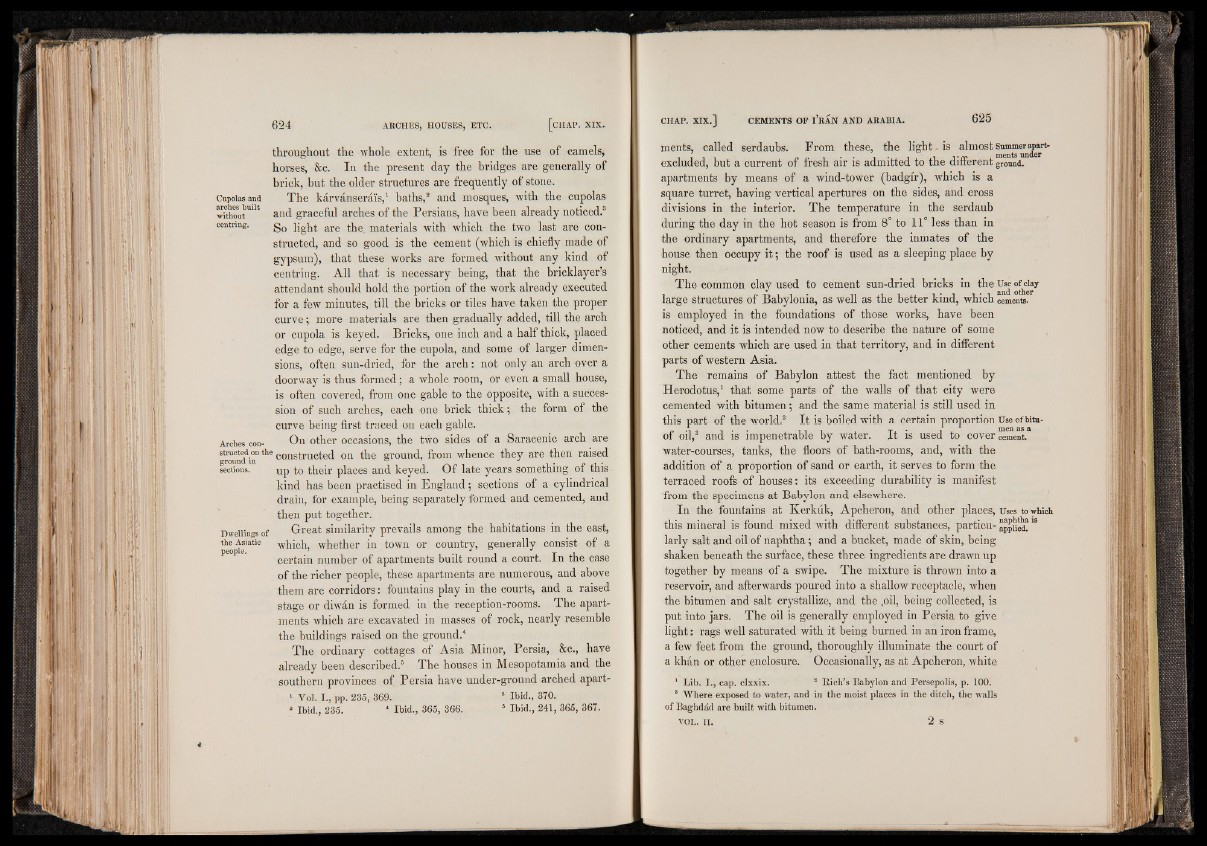
throughout the whole extent, is free for the use of camels,
horses, &e. In the present day the bridges are generally of
brick, but the older structures are frequently of stone.
Cupolas and The karvanserai’s,1 baths,8 and mosques, with the cupolas
wkhout™'1* and graceful arches of the Persians, have been already noticed.3
centring. gQ are the. materials with which the two last are constructed,
and so good is the cement (which is chiefly made of
gypsum), that these works are formed without any kind of
centring. All that is necessary being, that the bricklayer’s
attendant should hold the portion of the work already executed
for a few minutes, till the bricks or tiles have taken the proper
curve; more materials are then gradually added, till the arch
or cupola is keyed. Bricks, one inch and a half thick, placed
edge to edge, serve for the cupola, and some of larger dimensions,
often sun-dried, for the arch: not only an arch over a
doorway is thus formed; a whole room, or even a small house,
is often covered, from one gable to the opposite, with a succession
of such arches, each one brick thick; the form of the
curve being first traced on each gable.
Arches con- On other occasions, the two sides of a Saracenic arch are
stmcted on the constructed on the ground, from whence they are then raised
ground in ^ / ~ \ i • r *
sections. Up to their places and keyed. Of late years something 01 this
kind has been practised in England; sections of a cylindrical
drain, for example, being separately formed and cemented, and
then put together.
Dwellings of Great similarity prevails among the habitations in the east,
Asiatic w h i c h , whether in town or country, generally consist of a
certain number of apartments built round a court. In the case
of the richer people, these apartments are numerous, and above
them are corridors: fountains play in the courts, and a raised
stage or diwan is formed in the reception-rooms. The apartments
which are excavated in masses of rock, nearly resemble
the buildings raised on the ground.4
The ordinary cottages of Asia Minor, Persia, &c., have
already been described.5 The houses in Mesopotamia and the
southern provinces of Persia have under-ground arched apart-
1 Vol. I ., pp. 235, 369. 8 Ibid., 370.
3 Ibid., 235. 4 Ibid., 365, 366. 5 Ibid., 241, 365, 367.
<
ments, called serdaubs. From these, the light-is almost SummOTagart-
excluded, but a current of fresh air is admitted to the different ground,
apartments by means of a wind-tower (badgir), which is a
square turret, having vertical apertures on the sides, and cross
divisions in the interior. The temperature in the serdaub
during the day in the hot season is from 8° to 11° less than in
the ordinary apartments, and therefore the inmates of the
house then occupy i t ; the roof is used as a sleeping place by
night.
The common clay used to cement sun-dried bricks in the Use ofclay
large structures of Babylonia, as well as the better kind, which cements,
is employed in the foundations of those works, have been
noticed, and it is intended now to describe the nature of some
other cements which are used in that territory, and in different
parts of western Asia.
The remains of Babylon attest the fact mentioned by
Herodotus,1 that some parts of the walls of that city were
cemented with bitumen; and the same material is still used in
this part of the world.8 It is boiled with a certain proportion Use o f bitu-
of oil,3 and is impenetrable by water. It is used to cover cement,
water-courses, tanks, the floors of bath-rooms, and, with the
addition of a proportion of sand or earth, it serves to form the
terraced roofs of houses: its exceeding durability is manifest
from the specimens at Babylon and elsewhere.
In the fountains at Kerkuk, Apcheron, and other places, Uses to which
this mineral is found mixed with different substances, particu- appUed! *S
larly salt and oil of naphtha; and a bucket, made of skin, being
shaken beneath the surface, these three ingredients are drawn up
together by means of a swipe. The mixture is thrown into a
reservoir, and afterwards poured into a shallow receptacle, when
the bitumen and salt crystallize, and the ,oil, being collected, is
put into jars. The oil is generally employed in Persia to give
light: rags well saturated with it being burned in an iron frame,
a few feet from the ground, thoroughly illuminate the court of
a khan or other enclosure. Occasionally, as at Apcheron, white
1 Lib. I ., cap. clxxix. 8 Eieh’s Babylon and Persepolis, p. 100.
3 Where exposed to water, and in the moist places in the ditch, the walls
of Baghdad are built with bitumen.
VOL. II . 2 S